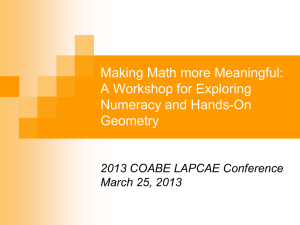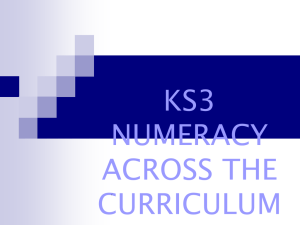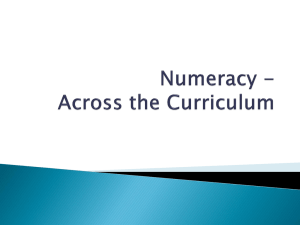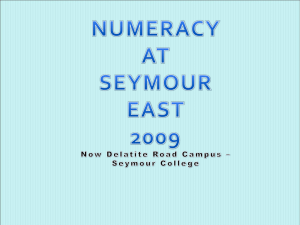Using Diagnostic Data-Reading & Maths
advertisement
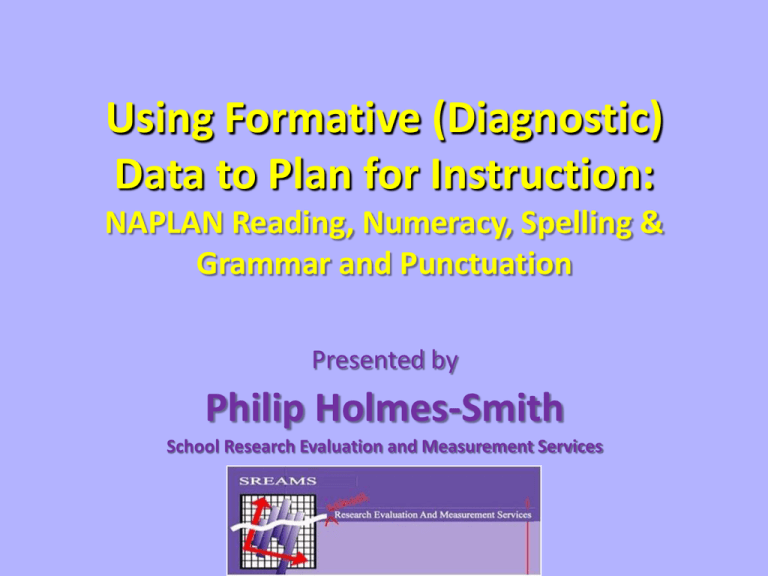
Using Formative (Diagnostic) Data to Plan for Instruction: NAPLAN Reading, Numeracy, Spelling & Grammar and Punctuation Presented by Philip Holmes-Smith School Research Evaluation and Measurement Services Overview of Session • Using Diagnostic Data to Plan for Instruction • Item Analysis – looking for guessing and misconceptions. • Item Analysis – looking for required skills • Zone of Proximal Development - Summarising strengths and weaknesses. The Item Analysis Report Roughly equal numbers selecting each of the wrong answers = guessing Nearly all students who got this wrong gave the same wrong answer = common misconception Year 3 Reading (Q16) Year 5 Reading (Q10) Correct = ? Most common incorrect = ? Year 3 Reading (Q16) Year 5 Reading (Q10) A B C D Year 3 25 7 58 8 Year 5 15 2 80 3 Year 5 Reading (Q25) Year 7 Reading (Q19) Correct = ? Most common incorrect = ? Year 5 Reading (Q25) Year 7 Reading (Q19) A B C D Year 5 27 16 5 51 Year 7 17 13 3 67 Year 3 Numeracy (Q24) Year 5 Numeracy (Q18) Correct = ? Most common incorrect = ? Year 3 Numeracy (Q24) Year 5 Numeracy (Q18) Responses A B C D Year 3 48 25 12 13 Year 5 80 13 4 3 Year 7 Numeracy (N08) Year 9 Numeracy (N07) Correct = ? Most common incorrect = ? Year 7 Numeracy (N08) Year 9 Numeracy (N07) Responses A B C D Year 7 23 10 3 64 Year 9 17 5 2 75 Year 7 Numeracy (N23) Year 9 Numeracy (N18) Correct = ? Most common incorrect = ? Year 7 Numeracy (N23) Year 9 Numeracy (N18) Responses A B C D Year 7 40 39 4 16 Year 9 49 33 4 14 Year 3 Numeracy (Q21) Year 5 Numeracy (Q15) Correct = ? Most common incorrect = ? Year 3 Numeracy (Q21) Year 5 Numeracy (Q15) Responses A B C D Year 3 9 57 27 6 Year 5 4 73 20 3 Suggested School activities The Student Response Report Choose “Student Response Report” Choose dimension and then either “Item Order” or “Difficulty order” The Student Response Report Increasing Level of Ability Data sorted by Item Difficulty and Student Ability Increasing Level of Difficulty Zone of Proximal Development (Vygotsky) Increasing Level Ability The known: What students can already do independently. The unknown: What students are incapable of learning before prior concepts are taught. Increasing Level of Difficulty Summarising strengths and weaknesses see SPA Year 3 Reading – The Known (What students can already do independently) Year 3 Reading – The Unknown (What students are incapable of learning before prior concepts are taught) Year 3 Reading – The Zone of Proximal Development (What students are capable of learning with the assistance of explicit instruction from the teacher [scaffolding] Diagnostic Testing (Feedback) • Hattie (2003)† shows that our most effective teachers (in terms of improving the learning outcomes of students) constantly use diagnostic information (Feedback) to inform their teaching. Hattie (2009)* shows that using feedback (i.e. using diagnostic information about what each student can and can’t do to inform teaching) has one of the biggest impacts on improving student learning outcomes. (Effect size =0.73) † 2003: http://www.acer.edu.au/documents/RC2003_Hattie_TeachersMakeADifference.pdf * 2009: Hattie, John. (2009). Visible Learning: A synthesis of over 800 meta-analyses relating to achievement. NY: Routledge. Suggested School activities • Use the currently available diagnostic tools such as: – – – – – – Fountas & Pinnell Benchmark Assessment System, Marie Clay Obs. Survey, English & Maths Online (Government schools); SINE (CEO schools), Probe 2, Stars & Cars, On-Demand Linear Tests. • Develop your own diagnostic tests – As part of your curriculum planning process, think about the knowledge and skills you will be covering in the upcoming unit of work and put together a pre-test to determine who knows what. • Using diagnostic information – Whether you are using a pre-existing test or your own pre-tests, use this diagnostic information to inform your teaching and learning activities and use them to inform your student groupings.
